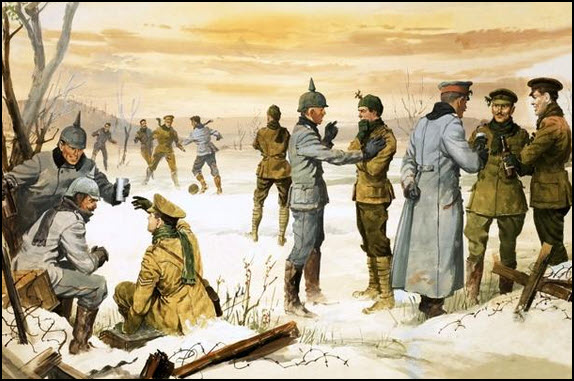“A Century Ago: The Unlikely Christmas Truce of 1917 and its Relevance Today”
In the chilling winter of 1917, amid the chaos and carnage of World War I, an extraordinary event unfolded on the Western Front—an informal ceasefire that came to be known as the Christmas Truce. In a remarkable display of shared humanity, roughly 100,000 British and German troops laid down their arms, creating a temporary sanctuary from the horrors of war.
Soldiers, who just days before were locked in a deadly dance of violence, found themselves shaking hands, exchanging gifts, and even singing Christmas carols together. The battlefield transformed into a surreal scene of camaraderie as the guns fell silent, and the cease-fire provided a respite for burial parties to retrieve fallen comrades. Joint services were held, and for a brief moment, enemies became friends.
The truce varied in duration across different sectors, with some lasting through Christmas night and extending until New Year’s Day. It was a rare instance where the spirit of Christmas overcame the brutality of war, reminding us of the power of common humanity even in the darkest of times.
As we reflect on this poignant episode from history, it raises a question: Have we lost the capacity for such empathy in the conflicts of today? The wars that plague our world, particularly those involving terrorist groups, seem devoid of the shared humanity that existed a century ago.
Unlike the wars of the past, contemporary conflicts with terrorist organizations present a unique challenge. They defy the traditional rules of engagement, making mediation and ceasefire agreements exceedingly difficult. The lack of recognized leadership to engage with leaves us grappling with an elusive enemy, one that operates outside the norms of conventional warfare.
There are reportedly 32 ongoing conflicts in the world right now, ranging from drug wars, terrorist insurgencies, ethnic conflicts, and civil wars. The Israel and Hamas war appears to be the most horrific example of a deadly conflict with zero elements of humanity emanating from Hamas. Then there is the war between Ukraine and Russia, which, initially thought to be an aggressive encroachment by Russia that would resolve quickly, has now turned into an ongoing and deadly battle pitting NATO and the UN against a new alliance between Russia and China. This new alliance threatens the United States in ways that eventually bring Americans unwillingly into WW3.
At this time, reflecting upon world conflicts, I question even more the reality of war and who or what is actually driving/directing the conflicts. Here at home in America, we do not want conflicts or war; the people of Ukraine and Russia do not want war; the people of Israel do not want war. So, exactly who, and for what means, is calling the shots to be fired?
This Christmas season, as we celebrate the birth of the Prince of Peace, whose life exemplified unconditional love, let us pause to consider the lessons of the Christmas Truce. It serves as a poignant reminder that, even in the face of seemingly insurmountable differences, there exists a shared humanity that can transcend the barriers of conflict.
In the year ahead, let our prayers be not only for peace on earth but for a day when conflicts are resolved without resorting to violence or the tragic loss of innocent lives. The Christmas Truce of 1917 of a century ago challenges us to aspire to a world where compassion triumphs over animosity, where enemies can find common ground, and where the spirit of goodwill prevails.
As we gather with loved ones and exchange gifts this holiday season, may we carry the message of the Christmas Truce with us—a message of hope, reconciliation, and the enduring possibility of peace, even in the most unlikely of circumstances.
Wishing each of you reading this a very Merry Christmas and Happy, Healthy Holiday season ahead. ~ Wayne Warrington

